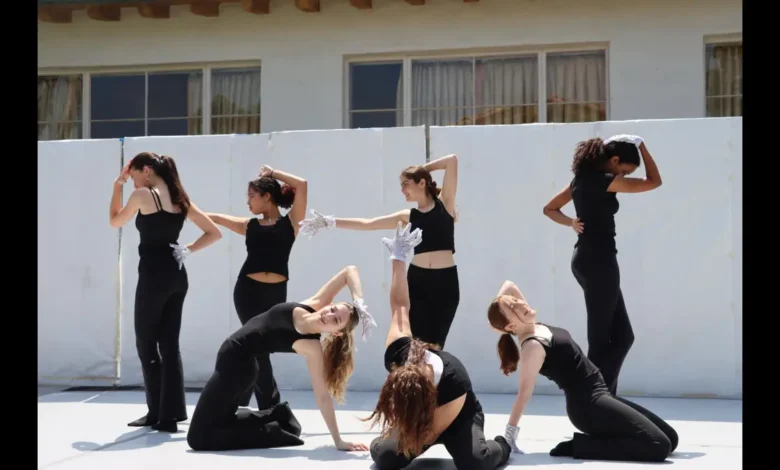Exploring the Impact of the Jacko Pose on Dance and Performance Art


Introduction to the Jacko Pose and Its Popularity
Get ready to strike a pose and groove to the rhythm because today, we are diving into the fascinating world of dance and performance art! In this blog post, we will explore the impact of a popular pose that has taken the artistic realm by storm – the Jacko Pose. Whether you’re an avid dancer, an art enthusiast, or simply someone who appreciates creativity in all its forms, join us as we uncover this iconic stance’s origins, evolution, and influence. So put on your dancing shoes, and let’s get ready to explore how the Jacko Pose has left an indelible mark on dance and performance art!
The Origins and Evolution of the Jacko Pose
It all began with Michael Jackson, the King of Pop himself. In the 1980s, he introduced a signature move that would later be known as the Jacko Pose. With one arm extended straight out to the side and the other bent at a right angle, it became an iconic image instantly recognizable worldwide.
But where did this pose come from? Some say it was inspired by Egyptian hieroglyphics depicting gods with their arms in similar positions. Others believe it was simply a unique creation of Jackson’s imagination – a way for him to express his individuality and captivate audiences.
Over time, the Jacko Pose evolved into more than just a dance move. It became a symbol of power, confidence, and artistic expression. Dancers and performers across different genres started incorporating variations of the pose into their routines, paying homage to Jackson’s influence on popular culture.
As dance styles continued to evolve, so did how artists incorporated elements of the Jacko Pose into their performances. Contemporary dancers used it as a tool to explore themes of identity and self-expression. Hip-hop dancers adopted their sharp angles and precise movements to add flair and intensity to their routines.
Even outside formal dance settings, people began emulating the pose in everyday life – striking poses reminiscent of Jackson’s iconic stance during photoshoots or impromptu moments captured on camera.
The evolution of technology also played a role in spreading awareness about this influential pose. Social media platforms allowed fans from all corners of the globe to share videos showcasing their interpretations or tributes using hashtags like #JackoPoseChallenge or #MJInspiredDanceMoves.
However, like any cultural phenomenon, there have also been criticisms surrounding its use. Some argue that overuse can lead to dilution or appropriation without proper understanding or respect for its origins within African American culture.
Regardless of these debates, the impact of the Jacko Pose on dance and performance art cannot be denied.
How the Jacko Pose Influenced Dance and Performance Art
The impact of the Jacko Pose on dance and performance art cannot be underestimated. This iconic pose, popularized by the legendary Michael Jackson, revolutionized how artists express themselves on stage. Its influence transcends time and continues to inspire dancers and performers worldwide.
The Jacko Pose brought a new energy and intensity to dance routines. With its dynamic angularity and powerful stance, it added an element of drama and flair that captivated audiences. Dancers began incorporating this pose into their choreography to showcase their skills and pay homage to Jackson’s incredible talent.
In addition to its visual appeal, the Jacko Pose also profoundly impacted storytelling in performance art. It allowed artists to embody different characters or emotions with just one striking gesture. Whether used to convey strength, vulnerability, or defiance, this pose became a powerful tool for communicating deeper messages through movement.
Many famous performances have incorporated the Jacko Pose as a nod to Jackson’s legacy. Artists like Beyoncé, Justin Timberlake, and Usher have all paid tribute to him by including elements of his signature moves in their routines. These performances showcase their admiration for Jackson and keep his spirit alive in contemporary dance.
However, some controversy has been surrounding using the Jacko Pose in performance art. Critics argue that relying too heavily on this iconic move can lead to unoriginality or mimicry rather than genuine creativity. They believe artists should strive for originality rather than simply imitating what has come before.
On the other hand, proponents argue that incorporating familiar poses like the Jacko Pose adds familiarity and resonance with audiences already connected with these movements through pop culture references. They see it as a way of honoring tradition while pushing boundaries creatively.
The future of the Jacko Pose in dance and performance art remains to be determined. While some may view it as an essential part of paying homage to an influential artist, others may seek to explore new and innovative movements.
Examples of Famous Performances Incorporating the Jacko Pose
The Jacko Pose has become an iconic dance and performance art symbol, inspiring countless artists to incorporate it into their routines. Its widespread popularity is a testament to its enduring impact on the industry.
One noteworthy example of the Jacko Pose in action is Beyoncé’s electrifying tribute to Michael Jackson at the 2009 MTV Video Music Awards. As she seamlessly transitioned from one MJ hit to another, Beyoncé flawlessly executed the signature pose, paying homage to the King of Pop himself. The audience was captivated by her sharp movements and undeniable stage presence.
Another unforgettable performance featuring the Jacko Pose was seen during Madonna’s Super Bowl halftime show in 2012. As she belted out her hit song “Vogue,” Madonna effortlessly struck various poses reminiscent of Jackson’s iconic stance, mesmerizing viewers worldwide.
In addition to these music superstars, many professional dancers have embraced the Jacko Pose to showcase their skills and pay tribute to one of dance history’s greatest legends. From contemporary dance pieces that blend traditional moves with modern interpretations to hip-hop performances that infuse Jackson-inspired choreography, dancers continue to use this pose as a powerful tool for self-expression.
Even beyond live performances, we see artists incorporating elements of the Jacko Pose into music videos and visual arts projects. The influence can be seen in everything from dynamic group formations mimicking his silhouette to individuals striking dramatic poses inspired by MJ’s famous lean.
By adopting this iconic pose, musicians and performers have been able to honor Michael Jackson and tap into his energy and charisma on stage. It allows them to connect with audiences deeper while showcasing theirque talents and creativity.
As we look towards future developments in dance and performance art, there is no doubt that we will continue seeing variations of the Jacko Pose incorporated into new routines. It has become an indelible part of pop culture history – a symbol that transcends time, inspiring future generations of artists to pay homage to
The Controversy Surrounding the Jacko Pose
Unsurprisingly, a pose as iconic and influential as the Jacko Pose has sparked its fair share of controversies. One of the main points of contention revolves around cultural appropriation. Critics argue that non-Black performers who use this pose are appropriating Black culture without fully understanding or respecting its historical context.
Others raise concerns about the commercialization and commodification of Michael Jackson’s image. They argue that by constantly replicating his signature moves, including the Jacko Pose, artists are capitalizing on his legacy for their gain rather than paying homage to his artistry.
Another aspect of controversy centers around allegations against Michael Jackson himself. Following accusations of sexual abuse made against him, some have questioned whether it is appropriate to continue celebrating and emulating a pose associated with someone accused of such heinous acts.
However, supporters counter these arguments by highlighting how dance and performance art thrive on emulation and inspiration from past icons. They argue that it is possible to appreciate and pay tribute to an artist’s contributions while acknowledging their flaws or controversial aspects.
The controversy surrounding the Jacko Pose reflects broader debates within popular culture about appropriation, accountability, and separating art from artists. It serves as a reminder that even seemingly innocent gestures can carry complex meanings in today’s social climate – forcing us all to reflect on our interpretations and intentions when engaging with iconic forms of expression like dance and performance art.
Criticisms and Praise for the Use of the Jacko Pose in Performance Art
Criticism and praise for using the Jacko Pose in performance art have been hotly debated within artistic circles. Some argue that incorporating this iconic pose is a cheap imitation of Michael Jackson’s unique talent, an attempt to ride on his coattails rather than showcasing originality. They believe it diminishes the integrity and creativity of dance and performance art.
On the other hand, some see the Jacko Pose as a homage to a legendary artist, recognizing its ability to pay tribute to Michael Jackson’s influence on popular culture. They argue that this pose allows performers to connect with audiences who appreciate and identify with his legacy.
Critics claim that relying too heavily on the Jacko Pose can lead to dance and performance art stagnation, preventing artists from exploring new movements or pushing boundaries. They argue that it promotes mediocrity instead of encouraging innovation.
However, supporters contend that incorporating such an iconic gesture can add familiarity and accessibility to performances. It serves as a nod to pop culture history while allowing artists to create unique interpretations through choreography or visual displays.
Opinions regarding using the Jacko Pose vary greatly among artists and audience members. While some view it as derivative or unoriginal, others see it as a powerful tool for expression and connection. The debate surrounding its merits will likely continue as critics and proponents make their cases in this ongoing conversation about dance and performance art aesthetics.
The Future of the Jacko Pose in Dance and Performance Art
As we look ahead to the future, it’s clear that the impact of the Jacko Pose on dance and performance art is far from over. This iconic pose has already become a classic, recognized and imitated by dancers worldwide.
In the coming years, we can expect to see even more innovative and creative uses of the Jacko Pose in performances. Dancers will continue to find new ways to incorporate this powerful pose into their routines, using it as a standalone move and as part of larger choreography.
One exciting possibility is how technology might play a role in expanding the potential of the Jacko Pose. With virtual and augmented reality advancements, performers could use these tools to enhance their movements and create immersive experiences for audiences.
Additionally, as new generations embrace Michael Jackson’s music and legacy, they will likely bring fresh interpretations and spin-offs of his iconic poses into their own dance styles. The influence of Jackson’s work will continue to be felt for years.
It’s worth noting that while some may criticize or question its validity as an artistic movement, there is no denying that the Jacko Pose has had a significant impact on popular culture. Its influence can be seen within dance and across various art forms such as photography, fashion, and even advertising.
Whether you love or loathe it, there is no denying that the future holds exciting possibilities for further exploration of this iconic pose. As long as artists continue pushing boundaries with creativity and innovation at its core – we can expect continued evolution in how dancers integrate this timeless move into their performances.
8
The Jacko Pose has undoubtedly left an indelible mark on dance and performance art. Its popularity, rooted in the influence of Michael Jackson’s iconic moves, has spread far and wide, captivating audiences around the globe.
From its humble beginnings as a signature pose in Jackson’s performances to its evolution into a widely recognized symbol of his artistry, the Jacko Pose has become synonymous with his unique style. It is a tribute to Jackson himself and a testament to his enduring legacy.
Through its incorporation into various dance routines and performance art pieces, the Jacko Pose has proven to be incredibly versatile. Artists from all disciplines have embraced this iconic move, adding their creative flair while paying homage to one of music’s greatest legends.
Famous performances such as those by Beyoncé during her Super Bowl halftime show or Bruno Mars at award ceremonies have showcased just how influential the Jacko Pose can be. By seamlessly blending it into their choreography, these artists have fostered a deeper connection between themselves and their audience.
However, controversy inevitably arises like any artistic expression that gains significant visibility. Some critics argue that using the Jacko Pose lacks originality or merely serves as an attempt for performers to ride on Jackson’s coattails. Others praise its inclusion in performances for honoring an artist who revolutionized popular music and dance.
Despite differing opinions surrounding its use, there is no denying that the impact of the Jacko Pose on dance and performance art has been profound. As artists continue to push boundaries and seek innovative ways to captivate audiences, we can expect this iconic pose to remain relevant for years.
In conclusion (without using “in conclusion”), whether you love it or question its significance, one thing is certain: The Jacko Pose stands tall as both a tribute and an inspiration within the realm of dance and performance art. Its ability to evoke emotions while preserving Michael Jackson’s unparalleled artistry is a testament to the power of movement and expression.
you may also read digitalfastnews.





